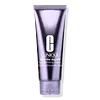What's inside
What's inside
 Key Ingredients
Key Ingredients

 Benefits
Benefits

 Concerns
Concerns

 Ingredients Side-by-side
Ingredients Side-by-side

Water
Skin ConditioningMyristic Acid
CleansingGlycerin
HumectantSodium Methyl Cocoyl Taurate
CleansingPotassium Hydroxide
BufferingLauric Acid
CleansingBehenic Acid
CleansingPPG-24-Glycereth-24
EmulsifyingSodium Hyaluronate
HumectantSodium Acetylated Hyaluronate
HumectantButylene Glycol
HumectantCaprylyl Glycol
EmollientGlycol Distearate
EmollientPolyquaternium-7
Hexylene Glycol
EmulsifyingTetrasodium EDTA
Phenoxyethanol
PreservativeSodium Benzoate
MaskingCI 60730
Cosmetic ColorantWater, Myristic Acid, Glycerin, Sodium Methyl Cocoyl Taurate, Potassium Hydroxide, Lauric Acid, Behenic Acid, PPG-24-Glycereth-24, Sodium Hyaluronate, Sodium Acetylated Hyaluronate, Butylene Glycol, Caprylyl Glycol, Glycol Distearate, Polyquaternium-7, Hexylene Glycol, Tetrasodium EDTA, Phenoxyethanol, Sodium Benzoate, CI 60730
Water
Skin ConditioningMyristic Acid
CleansingGlycerin
HumectantBehenic Acid
CleansingSodium Methyl Cocoyl Taurate
CleansingPotassium Hydroxide
BufferingPalmitic Acid
EmollientLauric Acid
CleansingStearic Acid
CleansingCaffeine
Skin ConditioningButylene Glycol
HumectantSucrose
HumectantSodium PCA
HumectantSodium Hyaluronate
HumectantTrehalose
HumectantPEG-3 Distearate
EmulsifyingUrea
BufferingPolyquaternium-51
Skin ConditioningTrisodium EDTA
Disodium EDTA
Phenoxyethanol
PreservativeWater, Myristic Acid, Glycerin, Behenic Acid, Sodium Methyl Cocoyl Taurate, Potassium Hydroxide, Palmitic Acid, Lauric Acid, Stearic Acid, Caffeine, Butylene Glycol, Sucrose, Sodium PCA, Sodium Hyaluronate, Trehalose, PEG-3 Distearate, Urea, Polyquaternium-51, Trisodium EDTA, Disodium EDTA, Phenoxyethanol
 Reviews
Reviews

Ingredients Explained
These ingredients are found in both products.
Ingredients higher up in an ingredient list are typically present in a larger amount.
Behenic Acid is a fatty acid and has moisturizing properties.
It is naturally occuring in the Moringa oleifera tree, rapeseed oil, and peanut oil.
This ingredient may not be Malassezia folliculitis, or fungal acne safe.
Learn more about Behenic AcidButylene Glycol (or BG) is used within cosmetic products for a few different reasons:
Overall, Butylene Glycol is a safe and well-rounded ingredient that works well with other ingredients.
Though this ingredient works well with most skin types, some people with sensitive skin may experience a reaction such as allergic rashes, closed comedones, or itchiness.
Learn more about Butylene GlycolGlycerin is already naturally found in your skin. It helps moisturize and protect your skin.
A study from 2016 found glycerin to be more effective as a humectant than AHAs and hyaluronic acid.
As a humectant, it helps the skin stay hydrated by pulling moisture to your skin. The low molecular weight of glycerin allows it to pull moisture into the deeper layers of your skin.
Hydrated skin improves your skin barrier; Your skin barrier helps protect against irritants and bacteria.
Glycerin has also been found to have antimicrobial and antiviral properties. Due to these properties, glycerin is often used in wound and burn treatments.
In cosmetics, glycerin is usually derived from plants such as soybean or palm. However, it can also be sourced from animals, such as tallow or animal fat.
This ingredient is organic, colorless, odorless, and non-toxic.
Glycerin is the name for this ingredient in American English. British English uses Glycerol/Glycerine.
Learn more about GlycerinLauric Acid is a fatty acid or lipid. About half of fatty acids in coconut oil is lauric acid.
This ingredient helps hydrate and sooth skin. As a humectant, it helps trap moisture. It also aids in cleaning and enhancing the texture of products.
Lauric acid may not be Malassezia folliculitis, or fungal acne, safe.
Learn more about Lauric AcidMyristic Acid is a saturated fatty acid. It is naturally found in milk fat. Other sources include palm oil, coconut oil, and butter fat.
Myristic Acid is an emulsifer and cleanser. As an emulsifer, it stabilizes a product by preventing ingredients from separating. Myristic Acid helps clean your skin by acting as a surfactant. It tends to gather oil and dirt on your skin to be easily rinsed away.
One study from 2021 found Myristic Acid to have anti-inflammatory properties.
Learn more about Myristic AcidPhenoxyethanol is a preservative that has germicide, antimicrobial, and aromatic properties. Studies show that phenoxyethanol can prevent microbial growth. By itself, it has a scent that is similar to that of a rose.
It's often used in formulations along with Caprylyl Glycol to preserve the shelf life of products.
Potassium hydroxide is commonly known as caustic potash. It is used to fix the pH of a product or as a cleaning agent in soap. In cleansers, it is used for the saponification of oils.
Sapnification is the process of creating fatty acid metal salts from triglycerides and a strong base. During this process, Potassium Hydroxide is used up and is not present in the final product.
Using high concentrations of Potassium Hydroxide have shown to irritate the skin.
Learn more about Potassium HydroxideSodium Hyaluronate is hyaluronic acid's salt form. It is commonly derived from the sodium salt of hyaluronic acid.
Like hyaluronic acid, it is great at holding water and acts as a humectant. This makes it a great skin hydrating ingredient.
Sodium Hyaluronate is naturally occurring in our bodies and is mostly found in eye fluid and joints.
These are some other common types of Hyaluronic Acid:
Learn more about Sodium HyaluronateThis gentle cleansing and foaming ingredient is known for leaving a smooth feeling in skin and hair. It is made using coconut oil.
According to the manufacturer, it is soluble in water and has resistance to hard water, acid, and alkali.
Due to its coconut base, it may not be Malassezia folliculitis safe.
Learn more about Sodium Methyl Cocoyl TaurateWater. It's the most common cosmetic ingredient of all. You'll usually see it at the top of ingredient lists, meaning that it makes up the largest part of the product.
So why is it so popular? Water most often acts as a solvent - this means that it helps dissolve other ingredients into the formulation.
You'll also recognize water as that liquid we all need to stay alive. If you see this, drink a glass of water. Stay hydrated!
Learn more about Water